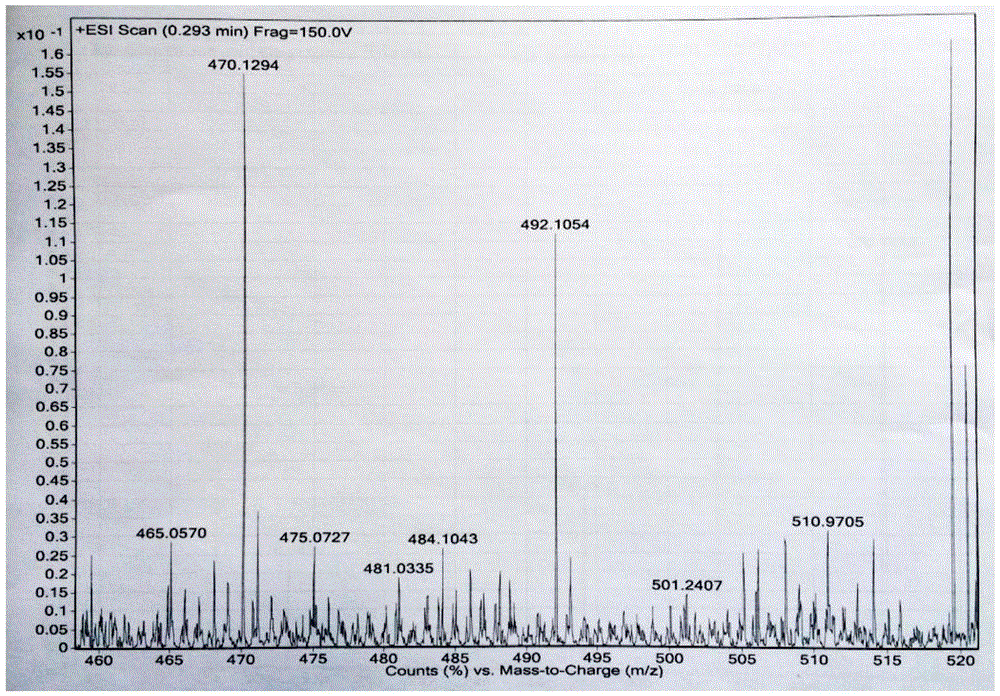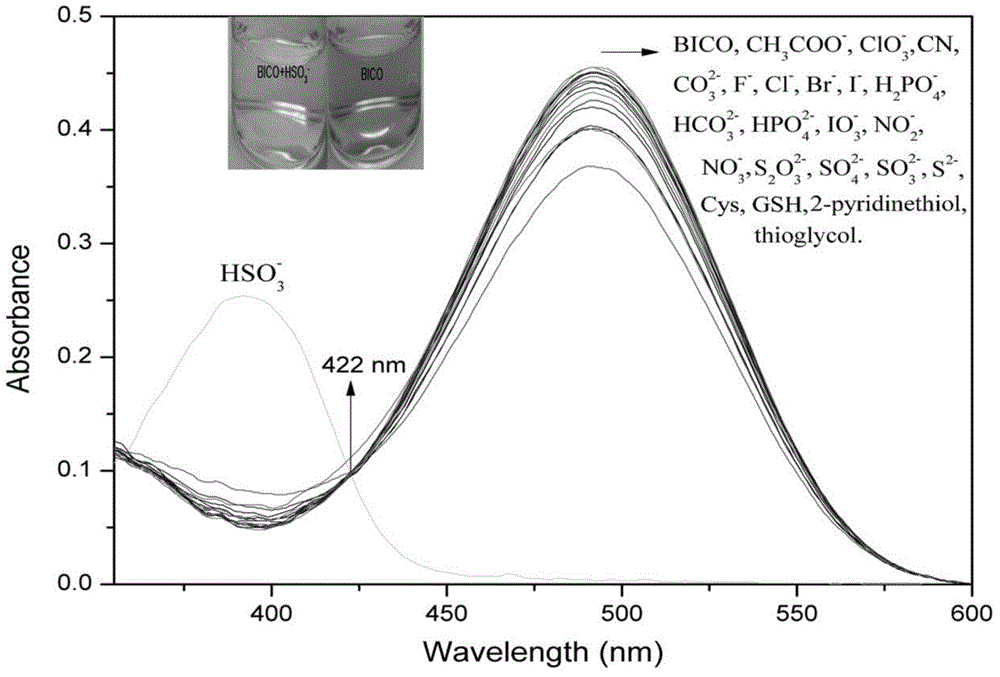Water-soluble sulphurous acid hydrogen root ratiometric fluorescent probe and application thereof
A ratiometric fluorescent probe, bisulfite technology, applied in fluorescence/phosphorescence, luminescent materials, organic chemistry, etc., can solve the problems of single-signal detection, inability to cell imaging, etc., and achieve the effect of broad application prospects
- Summary
- Abstract
- Description
- Claims
- Application Information
AI Technical Summary
Problems solved by technology
Method used
Image
Examples
Embodiment 1
[0026] Synthesize 3-formyl-7-diethylaminocoumarin and 5-acetylbenzimidazole by known methods, and then react the two to obtain 3-((3'-benzimidazole)-carbonyl with red fluorescence propene)-7-diethylaminocoumarin. specifically is:
[0027] Add 3-formyl-7-diethylaminocoumarin (1, 5.0mmol), 5-acetylbenzimidazole (2, 7.5mmol) and 1mL piperidine into 100mL absolute ethanol, heat to reflux , reacted for 9 hours and cooled to room temperature, a red solid precipitated out, suction filtered, washed three times with ethanol, and the crude product was recrystallized with ethanol to obtain a bright red solid that was 3-((3'-benzimidazole)-carbonylpropene)-7 -Diethylaminocoumarin (BICO), melting point: 287-292°C, yield 61%. single crystal figure 1 .
[0028] Infrared measurement (KBr, cm -1 ):3250(NH),3063(ArH),2969(CH 2 CH 3 ), 1721 (C=O), 1563 (C=C).
[0029] H NMR spectrum determination: 1 H NMR (400MHz, DMSO-d 6 ): δ=1.09(t, J=7.0Hz, 6H, CH3 ), 3.47 (q, J=7.0Hz, 4H, CH 2 ),...
Embodiment 2
[0035] Add 10 mL of 3-((3'-benzimidazole)-carbonylpropene)-7-diethylaminocoumarin to a solution of PBS buffer (CTAB 1mM, pH=7.4) with a micro-syringe , respectively quantitatively add 10 equivalents of Cys, GSH, mercaptoethanol, 2-aminopyridine, HSO 3 - ,CH 3 CO 2 - ,ClO 3 - ,CN - ,CO 3 2- ,H 2 PO 4 - , HCO 3 2- ,HPO 4 2- , F - , Cl - ,Br - , I - ,IO 3- ,NO 2- ,NO 3 - ,S 2- ,S 2 o 3 2- , SO 3 2- , SO 4 2- After 1 hour of action, UV-visible spectrophotometry and fluorescence spectrophotometry were tested, showing that the probe 3-((3'-benzimidazole)-carbonylpropene)-7-diethylaminocoumarin Bisulfite has good selectivity, and the comparison before and after adding bisulfite shows that the fluorescence emission wavelength has a blue shift of 147nm, which has a very good ratio response. See image 3 , 4.
Embodiment 3
[0037] Intracellular fluorescence imaging test:
[0038] The two groups A and B are the control group. Control group A: A549 cells were treated with 1.0 μM 3-((3'-benzimidazole)-carbonylpropene)-7-diethylaminocoumarin at 37°C. Cultivate in the cell culture medium of 1.0μM 2-(3-acetyl)coumarin-based acrylate for 1 hour; control group B: A549 cells were cultured in the cell culture medium of 1.0μM 2-(3-acetyl)coumarin-based acrylate for 1 hour, and washed three times with PBS buffer solution , and then again in 5 mM NaHSO containing 3 Soak in the cell culture medium for 0.5 hours.
[0039] Fluorescence imaging showed that 3-((3'-benzimidazole)-carbonylpropene)-7-diethylaminocoumarin penetrated into the cells. In the control group, the blue channel of A cells has no fluorescence, and the red channel has bright fluorescence. In the control group B, the blue channel showed fluorescence, and the red channel fluorescence was quenched. See Figure 5 .
PUM
 Login to View More
Login to View More Abstract
Description
Claims
Application Information
 Login to View More
Login to View More - R&D
- Intellectual Property
- Life Sciences
- Materials
- Tech Scout
- Unparalleled Data Quality
- Higher Quality Content
- 60% Fewer Hallucinations
Browse by: Latest US Patents, China's latest patents, Technical Efficacy Thesaurus, Application Domain, Technology Topic, Popular Technical Reports.
© 2025 PatSnap. All rights reserved.Legal|Privacy policy|Modern Slavery Act Transparency Statement|Sitemap|About US| Contact US: help@patsnap.com



